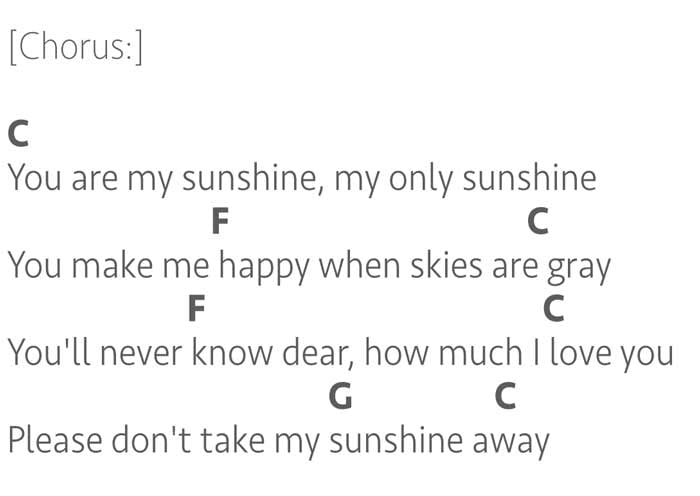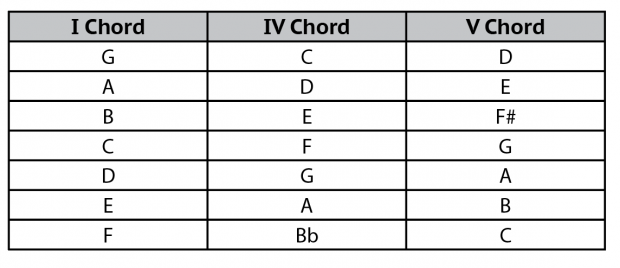The key of a song, for lack of a better description, is the chord around which the song is based. It is the chord that the song always comes back to for resolution. In other words, in a song like You are My Sunshine let’s say you are going to play it in the “key” of G. You would start strumming a G chord on your banjo. When you get to the word “happy,” you would change to a C chord. Then, when you sing the word “gray” you would go back to the G chord. Here’s the song listed below with the chords written above the words:
 See how the song starts on a G chord and ends on a G chord.
See how the song starts on a G chord and ends on a G chord.
Since most popular music is based on about three chords, you can use your knowledge of scales to help you find chords in different keys.
If you apply the major scale formula to the chromatic scale that we saw above, you will see that the fourth note in the G major scale is the note C. If you again apply the major scale formula the fifth note is D.
Remember, the major scale formula is two whole steps and a half-step than three whole steps and half-step. We’re not just counting four notes in the chromatic scale, we’re counting notes, using the formula for the major scale.
It is common in bluegrass, folk, and popular music to use three chords to create a song, regardless of what key the song is written in.
In our sample song above we played and sang it in the key of G. This means that we started on G and after playing C chords and a D chord, we ended up back at the G chord at the end of the song.
Using the major scale formula notice that the G chord is the number one chord, the C chord is the fourth note in the scale or more commonly referred to as the 4 chord and the D chord is the fifth note of the G major scale and more commonly referred to as the 5 chord.
We could play this same song, in the key of C by making the C chord the number one or root chord. If we used the major scale formula and began our scale on our banjos second string fretted at the first fret, that is a C note and that is the beginning of our scale. So we count up to whole steps and one half step and we end up at the sixth fret on the second string. That note is the fourth note in the C major scale and that would be the basis of our 4 chord. (That happens to be an F note… Which is nice to know but not critical to what we are doing here.)
To determine what our 5 chord is in the key of C, we would move up one more hole step (two more frets). The 5th note would be the basis of our 5 chord. (That happens to be a G note in the key of C which again is nice to know, but not critical.
Using our sample song You Are My Sunshine we can substitute a C chord where I’ve written a G chord. We can then substitute an F chord where I had previously written a C chord when playing the song in the key of G. Then, we can substitute a G chord where I had previously written a D chord when playing the song in the key of G. Using these new chords, C, F, and G, we have now “transposed” or moved to a different key our song “you are my sunshine”.
If you refer to the chart, and you see the root chord and the 4 and 5 chord next to the root chord, put those chords in place of the G chord, C chord, and D chord that you see in You Are My Sunshine and you can play and sing a song in each of those keys.
When playing with other instruments, you may be asked to play a song in a key that is more comfortable for the other musicians.
When playing with singers, some keys fit certain singers voices more comfortably. You may have found when trying to sing “you are my sunshine” in either the key of G or the key of C that you had trouble singing because you might have been pushed to sing too high for your voice or too low for your voice when you went from one key to the other.
The nice thing about knowing the major scale formula is that without knowing what the exact notes are, you might still be able to find the chords you’re looking for by finding the notes on the scale.
The chart here is a much handier reference and one that is a nice addition to any banjo case when printed off and kept in your banjo case accessory compartment.
 We are asked commonly, “how do you figure this key stuff out?” The answer, as you could see here, is knowing the major scale formula through which you can find virtually any 1, 4, and 5 chords starting on any note.
We are asked commonly, “how do you figure this key stuff out?” The answer, as you could see here, is knowing the major scale formula through which you can find virtually any 1, 4, and 5 chords starting on any note.
Remember the formula, and you can play any major scale starting at any fret on any string.
One of the biggest myths about the banjo is that it is hard to play. After generations of blisteringly fast bluegrass licks dominating the public's perception...
"Can you play clawhammer banjo on a resonator banjo?" It's a question that comes up fairly often both on online forums and out in the public. The answer is...
When it comes to Irish tenor banjo, it is hard to define exactly what type of banjo that is. Yes, it is a four string tenor banjo. But is it a 17-fret or a...
In this beginner 5 string banjo lesson, Jens Kruger shows you how you can easily play blues-inspired phrases on the 5-string banjo. Using the methods he...
3733 Kenora Dr.
Spring Valley, CA 91977
COMMENTS